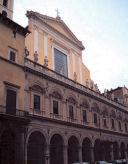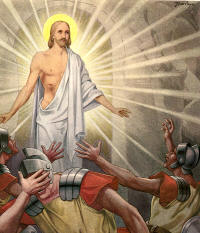» Enjoy our Liturgical Seasons series of e-books!
"Jesus himself stood among them and said to them, 'Peace be with you!'" The Gospel tells of an appearance of Jesus in the Cenacle on the very day of His resurrection. The newly baptized (neophytes) and all Christians with them, must live like the risen Christ, none but a heavenly life and by their manner of living proclaim their faith in Christ.
"This is the day the Lord has made, Alleluia!
Let us rejoice and be glad, Alleluia!"
Meditation: Grasping What the Resurrection Means
Keeping in mind the magnitude of the change wrought by the Resurrection—a divine action in history and nature that changed history and nature in a radical way, opening new possibilities of life beyond the reach of death—we can perhaps ponder with a bit more patience yet another gospel reading in which the disciples don’t at first, get it. Today’s Gospel account, read, appropriately enough, at the station of the Twelve Holy Apostles, picks up where yesterday’s gospel reading ended. The two disciples who recognized the Risen One in the breaking of bread (and, retrospectively, in his breaking open the Scripture for them in a new way) have returned to Jerusalem, where they have shared their experience with other friends of Jesus. Both the Emmaus disciples and the disciples in Jerusalem believe that Jesus has been raised; they accept the testimony of their own eyes and of other witnesses. But they still cannot grasp what this “being raised” means. So when the Risen One appears among them, their first reaction is to think that this is a “spirit,” a ghost.
The Lord chastises them mildly, pointing out that he has “flesh and bones” that a Spirit” would not have—and still they do not get it, although St. Luke tells us that they “disbelieved for joy”: that is, this is too good to be true. So the Lord asks for something to eat; they give him broiled fish, which he eats before them. Then, as he had done on the Emmaus road, he shows them from Scripture that the Anointed One of God had to suffer; that he then had to rise from the dead to a new form of life; and that repentance should be preached in his name “to all nations, beginning from Jerusalem.” They are, he concludes, “witnesses to these things” —which is to say, they have a mission, for which they will be equipped in due course by “power from on high,” in the gift of the Holy Spirit.
This pattern—incomprehension followed by divine instruction and example, and then by a gradual emerging of Easter faith in its fullness—has now occupied the first four days of the Easter Octave. It is striking that the Church made its own dullness and initial lack of understanding a central part of its preaching of the Resurrection—which is not precisely what modern marketers would recommend. Why? Why was this slowness to grasp the meaning of the New Life remembered? Why was it enshrined in the holy books of the New Covenant?
Benedict XVI, once again, suggested an answer. This was done, he wrote, because it accurately reflected the ways of God with humanity. Why didn’t God do things the way we would have done them—smiting the enemies of God with power, coming down from the Cross, revealing the Truth of the World and of history to the powerful and influential, rather than to a small band of illiterates, peasants, and pious women? Because, Pope Benedict reflected, God’s ways are not our ways:
It is part of the mystery of God that he acts so gently, that he acts so gently , that he gradually builds up his history within the great history of mankind; that he becomes man and so can be overlooked by his contemporaries and by the powers that shape history; that he suffers and dies and that, having risen again, he chooses to come to mankind only through the faith of the disciples to whom he reveals himself; that he continues to knock gently on the doors of our hearts and slowly opens our eyes if we open our doors to him.
And yet—is this not the truly divine way? Not to overwhelm with external power, but to give freedom, to offer and elicit love. And if we really think about it, is it not what seems so small that is truly great? Does not a ray of light issue from Jesus, growing brighter across the centuries, that could not come from any mere man and through which the light of God truly shines into the world? Could the apostolic preaching have found faith and built up a worldwide community unless the power of truth had been at work within it?
And because of that, nature and history, the material self and the soul, the world and the cosmos have been transformed: they have been brought into communion with God, who is both Creator and Redeemer. Because of that, we can see, with St. John (if more dimly than he saw), where all of this is heading:
Then I saw a new heaven and a new earth; for the first heaven and the first earth had passed away, and the sea was no more. And I saw the holy city, new Jerusalem, coming down out of heaven from God, prepared as a bride adorned for her husband; and I hear a great voice from the throne saying, “Behold, the dwelling of God is with men. He will dwell with them, and they shall be his people, and God himself will be with them; he will wipe away every tear from their eyes, and death shall be no more, neither shall there be mourning nor crying nor pain any more, for the former things have passed away.”
And he who sat upon the throne said, “Behold, I make all things new…” [Revelation 21:1-5a].
—George Weigel, Roman Pilgrimage: The Station Churches

Thursday in the Octave of Easter
Station with Santi Dodici Apostoli (Church of the Twelve Holy Apostles):
At Rome, the Station is in the Basilica of the Twelve Apostles, better known in Rome as better known as Santi Apostoli. The newly baptized were brought, today, into the church dedicated to the witnesses of the Resurrection, where repose the bodies of two out of the twelve: St. Philip and St. James the Less. An ancient inscription shows that this church was formerly dedicated to Philip and James.
For more on Santi Dodici Apostoli, see:
For further information on the Station Churches, see The Stational Church.








